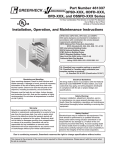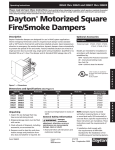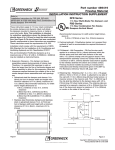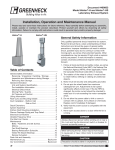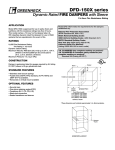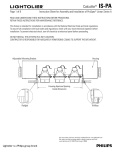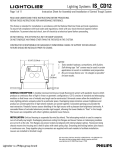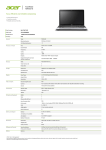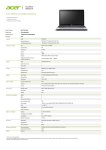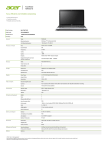Download Greenheck Fan FSDR-XXX User's Manual
Transcript
Part #461868 FSDR-XXX, SEFSDR-XXX, AND SSFSDR-XXX MODELS 1 1⁄2 Hour Fire & Combination Fire Smoke Dampers Vertical and Horizontal Mount Installation, Operation and Maintenance Instructions FSDR-XXX, SEFSDR-XXX, and SSFSDR-XXX Model Dampers are intended for installation in accordance with combination fire smoke damper requirements established by: National Fire Protection Association NFPA Standards 80, 90A, 92A, 92B & 101 BOCA National Building Codes ICBO Uniform Building Codes IBC International Building Codes SBCCI Standard Building Codes New York City (MEA listing #260-91-M) “UL CLASSIFIED (see complete marking on product)” “UL CLASSIFIED to Canadian safety standards (see complete marking on product)” UL Standard 555 & 555S (Classification #R13317) Receiving and Handling Warranty Upon receiving dampers, check for both obvious and hidden damage. If damage is found, record all necessary information on the bill of lading and file a claim with the final carrier. Check to be sure that all parts of the shipment, including accessories, are accounted for. Greenheck warrants this equipment to be free from defects in material and workmanship for a period of one year from the purchase date. Any units or parts which prove to be defective during the warranty period will be repaired or replaced at our option. Greenheck shall not be liable for damages resulting from misapplication or misuse of its products. Greenheck will not be responsible for any installation or removal costs. Greenheck will not be responsible for any service work or backcharges without prior written authorization. Dampers must be kept dry and clean. Indoor storage and protection from dirt, dust and the weather is highly recommended. Do not store at temperatures in excess of 100°F. Safety WARNING: Improper installation, adjustment, alteration, service or maintenance can cause property damage, injury or death. Read the installation, operating, and maintenance instructions thoroughly before installing or servicing this equipment. This manual is the property of the owner, and is required for future maintenance. Please leave it with the owner when the job is complete. Due to continuing research, Greenheck reserves the right to change specifications without notice. Table of Contents Pre-Installation Guidelines...................................................................................2 Electrical Guidelines.............................................................................................3 Installation.........................................................................................................3-7 •Clearances Required Between Fire Damper Sleeves and Wall/Floor Openings......3 •Sleeve Length and Wall Thickness .................................................................4 •Duct to Sleeve Connections ..........................................................................4 •Securing the Damper Assembly to Wall and Floor Openings..............................4 •Actuator Connections ..................................................................................5 •Connection and Operation of Temperature Control Devices.............................5-6 •FSDR-XXX and DFDR-XXX Blade Orientation....................................................6 •Recommended Preparation of Openings in Wood and Metal Stud Walls...............6 Maintenance.........................................................................................................7 Troubleshooting....................................................................................................7 Pre-Installation Guidelines The basic intent of a proper installation is to secure the fire smoke or fire damper in the opening in such a manner as to prevent distortion and disruption of damper operation. This is accomplished by allowing the fire or fire smoke damper in rated separation openings to expand and for the connecting duct to separate in the event of the collapse of the hanging system. The following items will aid in completing the damper installation in a timely and effective manner. 1) Check the schedules for proper damper locations within the building. Visually inspect the damper for damage and verify that the fusible link is in place or has not separated. If fusible link is not present or has separated, replace link. Never install a fire damper without the proper UL approved fusible link in place. (Fusible link is standard control option. An electric link may have been provided. Electric links have a button for resetting.) 2) Lift or handle damper using the frame. Do not lift damper using blades or actuators. 3) Do not install screws into the main body area of the damper frame as screws may interfere with and prevent damper blade from opening and/or closing. 4) Damper has label indicating position of damper assembly in the wall. Install accordingly to comply with manufacturer’s appropriate UL Classification file number. 5) Damper must be installed into duct or opening free of distortion or other misalignment. Damper must not be squeezed or stretched into duct or opening. Out of round, racked, twisted or misaligned installations can cause excessive leakage and/or torque requirements to exceed damper/actuator design. 6) Damper and actuator must be kept clean and protected from dirt, dust and other foreign materials prior to and after installation. Examples of such foreign materials include but are not limited to: a) b) c) d) e) Mortar dust Drywall dust Firesafing materials Wall texture Paint overspray 7) Damper should be sufficiently covered as to prevent overspray if wall texturing or spray painting will be performed within 5 feet of the damper. Excessive dirt or foreign material deposits on damper can cause excessive leakage and/or torque requirements to exceed damper/actuator design. 8) Caulking is not necessary, nor is it allowed, between the damper sleeve and the wall or floor opening (annular space). However, caulking may be applied to the retaining plates. 9) ACCESS: Suitable access (such that fusible links, RRL’s, actuators, and linkages can be maintained) must be provided for damper inspection and servicing. Where it is not possible to achieve sufficient size access, it will be necessary to install a removable section of duct. (Refer to NFPA 90A). 10)The Code Authority Having Jurisdiction (AHJ) must evaluate and provide approval of final installation where variations to these instructions are necessary. Electrical Guidelines All wiring shall be done in accordance with the National Electrical Code ANSI/NFPA-70 latest edition, any local codes that may apply, and wiring diagrams developed in compliance with the job or project design and specifications. SAFEty DANGER ! Electrical input may be needed for this equipment. this work should be performed by a qualified electrician. SAFEty CAUtION ! Verify power before wiring actuator. Greenheck is not responsible for any damage to, or failure of the unit caused by incorrect field wiring. SAFEty DANGER ! : to avoid causing death or serious bodily harm to building occupants, follow all instructions carefully. Dampers must close completely to preserve the integrity of the fire smoke separation. Installation - Failure to follow these instructions will void all warranties. These instructions apply to 11/2 hour rated combination fire smoke and fire dampers mounted (blades must be horizontal) in: 1) masonry, block or stud walls and 2) concrete floors or ceilings. Specific requirements in these instructions are mandatory. Dampers must be installed in accordance with these instructions to meet the requirements of UL 555 and UL 555S. The installation of the damper and all duct connections to the damper sleeve shall conform to the latest editions of NFPA 90A, Standard for the Installation of Air Conditioning and Ventilating Systems, and the SMACNA Fire, Smoke and Radiation Damper Installation Guide, and UL Classifications R13317. 1. CLEARANCES REQUIRED BEtWEEN FIRE DAMPER SLEEVES AND WALL/FLOOR OPENINGS Fire damper assemblies expand during periods of intense heat. Therefore, it is essential that openings in walls or floors be larger than the fire damper assembly to allow for this expansion. The wall/floor opening must be a minimum of 7/8 in. larger than the outside diameter of the damper. Refer to Section 4 for additional installation considerations. $-&"3"/$&'03 &91"/4*0/ %6$5 $0//&$5*0/ "3&" 015*0/"-#-"%&104*5*0/ */%*$"503"/%03&-&$53*$ -*/, %POPUQMBDFSFUBJOFS QMBUFJOUIJTHSPPWF */ */ '64*#-& -*/, -0$"5*0/ "*3'-08 */ 0QUJPOBM 4FDPOE 3FUBJOJOH 1MBUF */ */."9 %6$5 $0//&$5*0/ "3&" "$56"503 */."9 58 4-&&7&-&/(5) Fig. 1 5017*&80'%".1&3 3 2.SLEEVE LENGTH AND WALL/FLOOR THICKNESS 3.DUCT TO SLEEVE CONNECTIONS Insert the damper assembly into the prepared opening, to appropriate depth (see Page 3, Fig. 1). Dampers are supplied with sleeves and actuators from the factory and can be installed without the need for additional field installed sleeves. Recommended maximum and minimum insertion depth can be exceeded if: 1) the operation of the damper actuator is not impeded and 2) the CL of the damper blade remains within the plane of the wall/floor important safety dANGER! : To avoid causing death or serious bodily harm to building occupants, do not insert screws into the damper frame unless used for duct connection within 2 in. of the frame end. The sleeve may extend a maximum of 16 in. beyond the wall or floor on the actuator side of the damper and a maximum of 6 in. on the opposite side. Fig. 2 Gauge of factory furnished sleeve determines the type of duct to sleeve connections required (see table below). Any duct connection other than the breakaway connections are considered rigid. Type of Duct to Sleeve Gauge Duct Dimension Sleeve Connection Permitted 10 ga. (0.138 in.) 14 ga. (0.075 in.) 16 ga. (0.060 in.)24 in. max. dia. 20 ga. (0.036 in.) 24 in. max. dia. 4.SECURING THE DAMPER/SLEEVE ASSEMBLY TO WALL AND FLOOR OPENINGS $MBNQJOH 4DSFX JO.JO5ZQ 'BTUFOFST /VU 3FUBJOJOH 1MBUF"TTFNCMZ Damper assemblies must be installed in wall/floor openings using a single retaining plate on either side of the wall/floor or by using a retaining plate on both sides of the wall/floor. The use of a second retaining plate is allowed, but is not necessary. A single retaining plate is provided with the dampers. A second retaining plate can be ordered as an option. The outside dimension of the supplied retainer plate is nominal dia. + 4.50”. • The retaining plate(s) will open up for easy installation when the clamping screw is loosened. If necessary, remove the clamping screw and nut (see Fig. 2). (IMPORTANT: The clamping mechanism should face away from the wall/floor). Retainer plate(s) are designed to mount flush to the wall/floor and hold the damper in the wall/floor opening. • Place the damper and attached retainer plate into the wall/floor opening. • If a second retaining plate is being used, secure it on the opposite side of the wall/floor DO NOT POSITION RETAINER PLATE(S) IN FRAME GROOVE $MBNQJOH4DSFX Breakaway only Sleeve thickness must not be less than the gauge of the connecting duct. UL Standard 555 requires all ducts to terminate at fire damper sleeves. 0QFOJOHJO.JO .JOJNVN8BMM'MPPS0QFOJOH /PNJOBM%JBJO Rigid or Breakaway •Verify position, blade orientation, and actuator clearance then tighten the retainer plate clamping screws. The retainer plate(s) must overlap the wall/floor opening a minimum of 1 inch. Secure the retainer plate(s) to the wall using appropriate fasteners (minimum #8 sheet metal screws) at the four corners of each retainer plate when two retainer plates are used and also within 3⁄4 in. of the center of each plate when one retainer plate is used. 5.ACTUATOR CONNECTIONS Electrical and/or pneumatic connections to damper actuators should be made in accordance with wiring and piping diagrams developed in compliance with applicable codes, ordinances and regulations (see Electrical Guidelines). 6.CONNECTION AND OPERATION OF TEMPERATURE RESPONSE DEVICES (Fusible Link, RRL OPTION, OCI OPTION, TOR OPTION, and PRV OPTION) RRL - Dampers will be supplied with a fusible link temperature response device, as a standard. An optional thermostat type temperature response device may have been installed. The device is a RRL (resetable link device), which only incorporates one thermostat and therefore the damper remains closed as soon as its sensor temperature is reached. The RRL does not contain blade indication switches. Refer to Fig. 4 on page 5 for wiring of the RRL thermostat. OCI - The OCI (open or closed indicator) option contains a single pole, double throw switch used to indicate the damper blade position. The switch provides a positive open or closed signal when used in conjunction with remote indicator lights. Refer to Fig. 5 on page 5 for wiring of the OCI option. TOR - The TOR (temperature override device) option incorporates two thermostats with fixed settings (usually 165°F and 350°F). The primary sensor (the sensor with the lower temperature setting) can be bypassed by an external electrical signal allowing the damper to reopen until the temperature reaches the setting of the secondary sensor (the sensor with the higher temperature setting). When the temperature of the secondary sensor is exceeded the damper closes and remains closed thereafter (Fig. 6) Fig. 3 ELECTRICAL CAPACITY = 10 AMP @ 120 / 240 VAC PRV - The PRV (pneumatic relief valve) option is heat responsive device used with pneumatic actuators. This can be used in place of EP switch where a RRL is used. The PRV activates when temperature in excess of the temperature of the fusible link are detected. When the fusible link melts, air from the actuator is exhausted to close the dampers. Pneumatic actuators are to be piped per local code. NC ORANGE BLACK L2 BLACK WHITE/RED M P PRIMARY TEMP SENSOR ELECTRIC DAMPER ACTUATOR OR PNEUMATIC SOLENOID VALVE Fig. 4 /05& 5)&48*5$)8*3&483"11&%8*5) "#-6&."3,&3*/%*$"5&5)& $-04&%104*5*0/0'5)&%".1&3 &-&$53*$"-$"1"$*5:".1!7"$ The TOR assembly also contains a single pole, double throw switch used to indicate damper blade position. The switch provides a positive open or closed signal when used in conjunction with remote indicator lights. See page 6, Fig. 6 for wiring of the TOR thermostats and indicator switches. If either the TOR or the RRL is ordered with a pneumatic actuator, an EP switch is required with an appropriate electric power circuit to allow the electric thermostat to control the pneumatic actuator. RRL Wiring L1 - - OCI Wiring #:05)&34 :&--08 4 :&--08 4 :&--08 /0 :&--08 %".1&3 */%*$"503 -*()54 /0 Fig. 5 RATINGS (Fig. 4 & 5) Integral Switch Type: Single Pole, double throw Electrical: 10 Amps, 1/3 hp, 120 or 240 Vac 1/2 Amp, 125 Vdc; 1/4 Amp 250 Vdc 5 Amps, 120 Vac “L” (lamp load) 1.0 Amps, 24 Vac 1.5 Amps, 24 Vdc Temperature Limit: 165° F ( standard primary sensor) 212° F ( optional primary sensor) 250° F ( secondary sensor) 350º F ( secondary sensor) 5&.1&3"563&-*.*5&%07&33*%& 01&/$-04&%*/%*$"503 RATINGS (Fig. 6) Integral Switch Type: Single Pole, double throw TOR Wiring /05& 5)&48*5$)8*3&483"11&%8*5) "#-6&."3,&3*/%*$"5&5)& $-04&%104*5*0/0'5)&%".1&3 &-&$53*$"-$"1"$*5:".1!7"$ - - #308/ 03 0'' 03"/(& 0/ /$ #308/ /$ #-"$, 8)*5& . )-)*()-*.*54&/403 113*."3:5&.14&/403 0307&33*%& 1 :&--08 4 :&--08 4 )- #:05)&34 :&--08 /0 &-&$53*$%".1&3 "$56"503031/&640-&/0*% 7"-7& Electrical: 10 Amps, 1/3 hp, 120 or 240 Vac 1/2 Amp, 125 Vdc; 1/4 Amp 250 Vdc 5 Amps, 120 Vac “L” (lamp load) 1.0 Amps, 24 Vac 1.5 Amps, 24 Vdc %".1&3 */%*$"503 -*()54 :&--08 /0 Fig. 6 Temperature Limit: 165° F (standard primary sensor) 212° F (optional primary sensor) 250° F (secondary sensor) 350º F ( secondary sensor) FSDR-XXX and DFDR-XXX Blade Orientation 30° Axle 30° Axle Axle 30° Off Horizontal (Maximum) 30° Off Horizontal (Maximum) Normal 8.Recommended Preparation of Openings in Wood and Metal Stud Walls %".1&3'3".& • Frame wall openings as shown. (see Fig. 7) • Double vertical studs are not required for openings 36 in. x 36 in. or smaller. .&5"- • Gypsum wall board must be fastened 12 in. on center to all stud and runner flanges surrounding opening. (see Fig. 8) 456% .*/ • All construction and fasteners must meet the requirements of the appropriate wall design (See UL Fire Resistance Directory) and/or local codes. %0/051-"$& 3&5"*/&31-"5& */5)*4(3007& JOPD .BYJNVN NFUBMTUVET JOPD .BYJNVN NFUBMTUVET $FJMJOH3VOOFS %".1&3'3".& JO 800% 456% JOPD .BYJNVN .*/ JO 1BOIFBE 4DSFXT JOPD .BYJNVN XPPETUVET Fig. 8 JO %0/051-"$& 3&5"*/&31-"5& JOPD .BYJNVN XPPETUVET */5)*4(3007& Fig. 7 'MPPS3VOOFS 9.Round Duct Connections Round duct connections to shall be attached with #8 sheet metal screws as follows: • Ducts 22 in. dia. and smaller shall have three screws. • Ducts larger than 22 in. dia. up to and including 24 in. dia. shall have five screws. NOTE: All breakaway connections described may have duct sealant, PA2084T duct sealant adhesive manufactured by Precision, DP1010 water base duct sealant manufactured by Design Polymetrics, or Grey Pookie applied in accordance with SMACNA recommendations. Damper Maintenance Dampers do not typically require maintenance as long as they are kept dry and clean. If cleaning is necessary, use mild detergents or solvents. If lubrication is desired for components such as axle bearings, jackshaft bearings and jamb seals, do not use oil-based lubricants or any other lubricants that attract contaminants such as dust. Dampers and their electric/pneumatic actuator(s) must be maintained, cycled, and tested in accordance with: • The latest editions of NFPA 80, 90A, 92A, UL864, and local codes. • Actuator manufacturer recommendations. Damper Trouble Shooting The following is a possible cause and correction list for common concerns with the dampers. Symptom Possible Cause Corrective Action Frame is out of round causing Adjust frame such that it is round blades to bind on jamb seals Actuator linkage loose Close damper, disconnect power, adjust Damper does not Defective motor fully open and/or Screws in damper linkage fully close Actuator linkage hitting wall or floor and tighten linkage out to line designated on damper label. Clean with a non-oil-based solvent Contaminants on damper Replace Locate screws and remove Damper installed too far into wall. Move (see Damper Maintenance) RRL, or TOR sensor tripped Heat Damper does not operate No power supplied to the actuator Actuator runs hot or makes a humming noise Actuator prohibited from reaching end of stroke Disconnect linkage from jackshaft, open damper, power actuator to end of spring, tighten linkage. Verify amp draw. Link separated Heat Replace link Push reset button located on backside of RRL or TOR. Copyright © 2006 Greenheck Fan Corporation 461868 FSDR-XXX Rev. 7 March 2006







